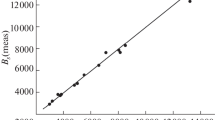Abstract
The paper argues in favor of the assumption that magnetic and non-magnetic protostars, from which CP stars were formed, are the objects that had rotation velocities of the parent cloud V smaller than a critical value V c . At V greater than the critical value, differential rotation emerges in the collapsing protostellar cloud, which twists magnetic lines of force into an’ invisible’ toroidal shape and disturbs the stability of the atmosphere. In magnetic protostars, the loss of angular momentum is due to magnetic braking, while in metallic protostars, the loss of rotation momentum occurs due to tidal interactions with a close component. HgMn stars are most likely not affected by some braking mechanism, but originated from the slowest protostellar rotators. The boundary of V c where the differential rotation occurs is not sharp. The slower the protostar rotates, the greater the probability of suppressing the differential rotation and the more likely the possibility of CP star birth.
Similar content being viewed by others
References
K. Stȩpień, Astron. and Astrophys. 353, 227 (2000).
K. Stȩpień and J. D. Landstreet, Astron. and Astrophys. 384, 554 (2002).
Y. V. Glagolevskij, Astrophysical Bulletin 72, 305 (2017).
H. A. Abt, Publ. Astron. Soc. Pacific 77, 367 (1965).
H. A. Abt and N. I. Morrell, Astrophys. J. Suppl. 99, 135 (1995).
H. A. Abt and M. S. Snowden, Astrophys. J. Suppl. 25, 137 (1973).
T. C. Mouschovias and E. V. Paleologou, Astrophys. J. 230, 204 (1979).
H. A. Abt, Publ. Astron. Soc. Pacific 77, 367 (1965).
D. L. Moss, Monthly Notices Royal Astron. Soc. 168, 61 (1974).
D. L. Moss, Monthly Notices Royal Astron. Soc. 171, 303 (1975).
Y. V. Glagolevskij and E. Gerth, Bull. Spec. Astrophys. Obs. 55, 38 (2003).
P. A. Sweet, Monthly Notices Royal Astron. Soc. 110, 548 (1950).
J.-L. Tassoul and M. Tassoul, Astrophys. J. Suppl. 49, 317 (1982).
G. Michaud, Astrophys. J. 258, 349 (1982).
G. Michaud, D. Tarasick, Y. Charland, and C. Pelletier, Astrophys. J. 269, 239 (1983).
A. V. Tutukov, Pis’ma Astron. Zh. 9, 160 (1983).
P. Bodenheimer, IAU Symp. 93, 5 (1981).
V. Petit, S. P. Owocki, G. A. Wade, et al., Monthly Notices Royal Astron. Soc. 429, 398 (2013).
H. A. Abt and N. I. Morrell, Astrophys. J. Suppl. 99, 135 (1995).
A. Uesugi and I. Fukuda, Memoirs Faculty of Sciences University of Kyoto 33, 205 (1970).
H. A. Abt, H. Levato, and M. Grosso, Astrophys. J. 573, 359 (2002).
D. A. Bohlender, J. D. Landstreet, and I. B. Thompson, Astron. and Astrophys. 269, 355 (1993).
H. A. Abt, Astron. J. 122, 2008 (2001).
M. E. Boyarchuk and I. M. Kopylov, Izv. Krymskoj Astrofizicheskoj Observatorii 31, 44 (1964).
H. Levato, S. Malaroda, N. Morrell, et al., Astron. and Astrophys. Suppl. 118, 231 (1996).
E. Paunzen and H. M. Maitzen, Astron. and Astrophys. Suppl. 133, 1 (1998).
Y. Y. Balega, V. V. Dyachenko, A. F. Maksimov, et al., Astrophysical Bulletin 67, 44 (2012).
V. G. Klochkova and I. M. Kopylov, Sov. Astron. 29, 549 (1985).
Y. V. Glagolevskij, Astrophysics 53, 536 (2010).
Y. V. Glagolevskij and A. F. Nazarenko, Astrophysical Bulletin 72, 2017 (in press).
M. R. Molnar, T. C. Stephens, and A. D. Mallama, Astrophys. J. 223, 185 (1978).
Y. V. Glagolevskij, Astrophysical Bulletin 66, 144 (2011).
Y. V. Glagolevskij, V. V. Leushin, G. A. Chuntonov, and D. Shulyak, Astronomy Letters 32, 54 (2006).
G. A. Wade, J.-F. Donati, J. D. Landstreet, and S. L. S. Shorlin, Monthly Notices Royal Astron. Soc. 313, 851 (2000).
Y. V. Glagolevskij, Astrophysical Bulletin 69, 305 (2014).
M.-F. Nieva, Astron. and Astrophys. 550, A26 (2013).
S. L. S. Shorlin, G. A. Wade, J.-F. Donati, et al., Astron. and Astrophys. 392, 637 (2002).
E. F. Borra and J. D. Landstreet, Astrophys. J. Suppl. 42, 421 (1980).
E. F. Borra, J. D. Landstreet, and I. Thompson, Astrophys. J. Suppl. 53, 151 (1983).
G. A. Wade, P. North, G. Mathys, and S. Hubrig, Astron. and Astrophys. 314, 491 (1996).
O. Kochukhov, N. Piskunov, I. Ilyin, et al., Astron. and Astrophys. 389, 420 (2002).
G. A. Wade, E. Neagu, and J. D. Landstreet, Astron. and Astrophys. 307, 500 (1996).
G. Giuricin, F. Mardirossian, and M. Mezzetti, Astron. and Astrophys. 135, 194 (1984).
V. V. Leushin, Y. V. Glagolevskij, and P. North, in Proc. Intern. Conf on Magnetic Fields of Chemically Peculiar and Related Stars, Nizhnij Arkhyz, Russia, 1999, Ed. by Y. V. Glagolevskij and I. I. Romanyuk (Moscow, 2000), pp. 173–179.
Author information
Authors and Affiliations
Corresponding author
Additional information
Original Russian Text © Yu.V. Glagolevskij, 2017, published in Astrofizicheskii Byulleten’, 2017, Vol. 72, No. 4, pp. 457–484.
Rights and permissions
About this article
Cite this article
Glagolevskij, Y.V. On mechanisms separating stars into normal and chemically peculiar. Astrophys. Bull. 72, 418–446 (2017). https://doi.org/10.1134/S199034131704006X
Received:
Accepted:
Published:
Issue Date:
DOI: https://doi.org/10.1134/S199034131704006X



